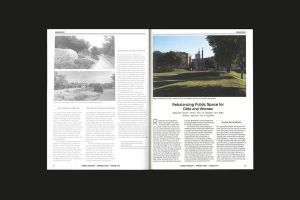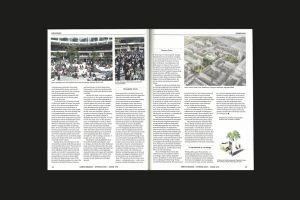Urban Design Journal, Issue 170, Spring 2024
Urban Design Journal spotlights three of our projects that employ co-design as a technique for the betterment of public space and call for its adoption by councils and regional bodies around the nation. When we design for the needs of marginalised and vulnerable groups, the benefits will always cascade to the majority.
Our work at Vauxhall Pleasure Gardens has developed over the last 20 years and provided one of our earliest involvements with design that was informed by community-engagement and public consultation. We learned that providing a voice for local communities requires earning trust and demonstrating a commitment to engage and offer something back.
In 2015, we were asked to help with British Land’s inclusive, human-centric redesign of Broadgate Circle. Using prefabricated moveable planters with integrated sheltered seating, we were able to transform an intimidating, male-dominated arena nicknamed the ‘Bear Pit’ into a variegated and active local square. We observed a more balanced gender ratio and variation of activities for example, gatherings of smaller groups for respite, or even people sitting alone with a book.
The masterplan for Somers Town provided culmination of our work designing for and alongside marginalised groups such as women and girls. We worked closely with a group of young local Muslim women who helped us understand how the place was used by residents on a daily basis and how it could be improved. The proposal includes a diverse range of play and social spaces, suited to the needs of different user groups which were communicated through our engagement process.
Beyond the completion of a project, we continue to empower the local residents, young and old, as experts on local issues. At Somers Town, long-term community engagement approaches, punctuated by focussed periods of co-design, have underpinned the development of the masterplan.
This project helps to illustrate our belief that the co-design of public spaces should stretch beyond the initial completion and include a 'constitution' in which stakeholders agree on a set of values at the very start of the design process, and which are then embedded in the space over time. Any necessary interventions beyond the initial completion can then be guided by this document, ensuring lasting benefits for the local community.

